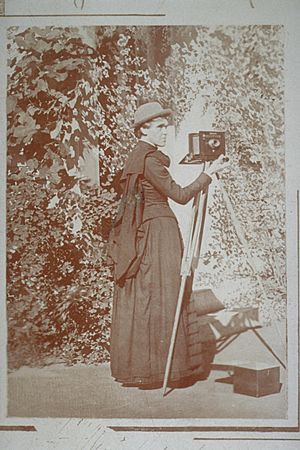E. Jane Gay facts for kids
Quick facts for kids
E. Jane Gay
|
|
|---|---|

E. Jane Gay with her camera, c. 1889–1897
|
|
| Born |
Elizabeth Jane Gay
July 27, 1830 |
| Died | (aged 88) Winscombe, Somerset, England
|
| Nationality | American |
| Other names | E. Jane Gay |
| Occupation | Photography |
| Known for | Social reform; images of the Nez Perce |
E. Jane Gay was an American woman who lived from 1830 to 1919. She spent her life working to make society better and taking amazing photographs. She is especially known for her pictures of the Nez Perce people. She took these photos during a special trip with a scientist named Alice Cunningham Fletcher.
Early Life
Elizabeth Jane Gay was born in 1830 in Nashua, New Hampshire. Her parents were Ziba and Mary Gay. She went to school at the Brooklyn Female Academy in New York. There, she became good friends with Alice Cunningham Fletcher. At school, Jane studied science, religion, and home skills.
What She Did
Gay's first job was as a teacher. In 1856, she helped open a school for girls in Macon, Georgia. When that school closed, she moved to Washington, D.C.. There, she helped run a school for young deaf children.
From 1861 to 1865, Gay worked as a nurse during the American Civil War. She worked with a famous nurse named Dorothea Dix. After the war, Gay tutored the grandchildren of President Andrew Johnson. Later, she worked in an office that handled lost mail.
In 1888, Gay reconnected with her old friend, Alice Cunningham Fletcher. Around this time, Gay taught herself how to take photographs. In 1889, the U.S. government asked Fletcher to lead a special trip. This trip was to Nebraska and Idaho. The goal was to divide tribal lands among the Winnebago and Nez Perce people. This was part of a law called the Dawes Act.
Gay went with Fletcher on this important journey. She helped as a cook, maid, and secretary. Even though she wasn't the "official" photographer, Gay took over 400 pictures of the Nez Perce people. In 1909, she worked with her niece to publish a book. It included letters from the trip and many of her photographs. The book was called Choup-nit-ki: With the Nez Percés.
Her Photography
Gay's photographs of the Nez Perce are now getting a lot of attention. Her black and white photos often show the Nez Perce in Western clothes. They are seen working on farms or ranches. They live in cabins and do manual labor. These pictures seemed to show that the government's land program was working.
However, today's experts look at these photos differently. They see themes of nationalism (strong loyalty to one's country) and colonialism (one country controlling another). Some photos show the white, tall Alice Fletcher standing over the Nez Perce. The Nez Perce subjects are often working or in less powerful poses. Gay's photos also showed how different jobs were given to men and women, and to different races.
Personal Life
E. Jane Gay never married or had children. But she was very close to her niece, Emma Jane Gay. After her trip with Alice Fletcher, Gay returned to Washington, D.C. She and Alice Fletcher shared a house. Later, Gay and Emma traveled to England for a long visit.
With Emma's help, Jane Gay made a special scrapbook. It contained edited letters from her years in Idaho. It also had some of her photographs and extra artwork by Emma. Emma, who studied bookbinding, put the scrapbook into two volumes. She even built a wooden case for it. This work was titled "Choup-nit-ki: With the Nez Percés."
Gay decided to stay in Somerset, England. She lived with her close friend, Dr. Caroline Sturge. After World War One, Dr. Sturge used her inheritance to build a cottage. It was in Winscombe, Somerset. This is where she and Gay lived out their final years. Gay passed away in this cottage, named "Kamiah," on March 15, 1919.
Images for kids
-
Monday Morning at Camp McBeth, Idaho State Historical Society




